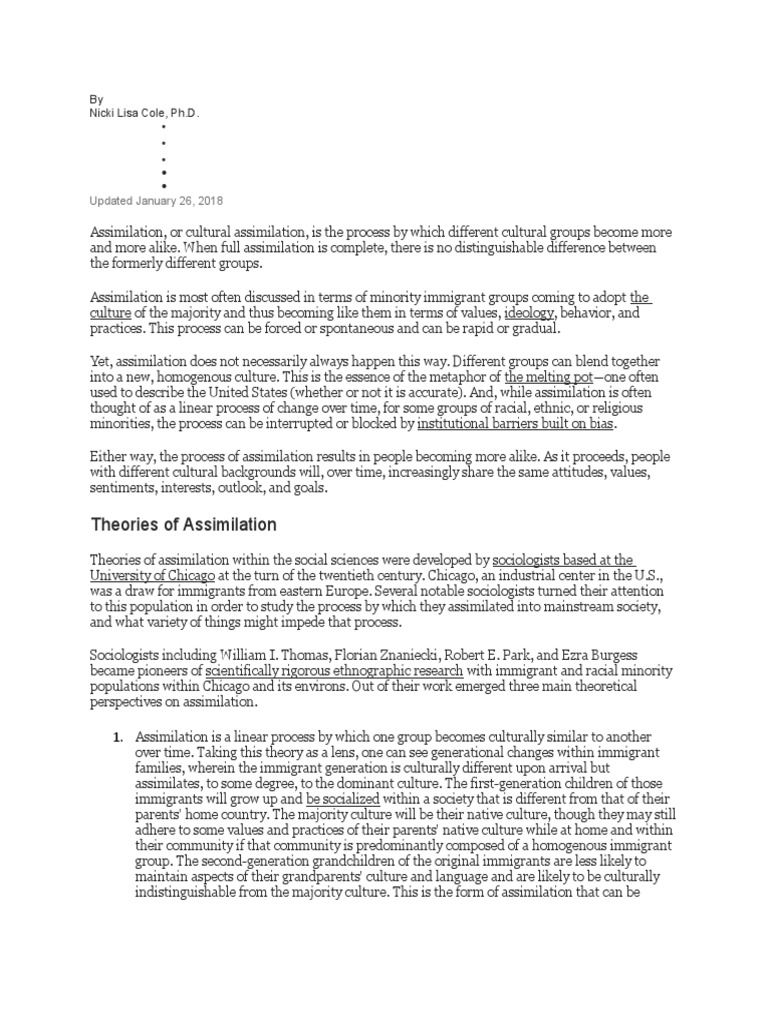In the vast tapestry of the United States, assimilation is a multifaceted phenomenon, akin to rivers converging into a single stream while simultaneously preserving the uniqueness of their tributaries. Cultural blending occurs as diverse groups interface, yet remnants of originality persist, resulting in an intricate dance of identity, resistance, and adaptation. This article delves into the dynamics of assimilation through the lens of cultural relativism, an approach that seeks to understand cultures on their terms, rather than imposing external judgments.
Assimilation can be envisaged as a double-edged sword, wielded by both individuals seeking acceptance and a sociopolitical system that often prioritizes homogeneity. The historical context of the United States is replete with instances that elucidate this tension between blending and resistance. For example, the early settlers sought to create a New World where they could cultivate a distinct identity, often subjugating indigenous populations in the process. Such foundational narratives framed the American ethos, establishing a paradigm where cultural divergence was viewed with suspicion.
As waves of immigrants traversed the ocean, the quest for assimilation became a prevailing theme. The Irish, Italians, Poles, and other groups entered the tapestry of American culture, each contributing unique elements while confronting the pressures to conform. The metaphor of the melting pot serves as an apt description, suggesting a homogenization of cultures into a cohesive identity. However, this metaphor often belies the complexities inherent in cultural exchange. The more accurate term, “salad bowl,” illustrates how distinct identities can coexist, melding but not losing their original flavors. In this view, the assimilation experience becomes a negotiation, where individuals sometimes relinquish parts of their cultural identity but retain essential aspects that define their heritage.
Cultural relativism posits that no culture is inherently superior or inferior; rather, each possesses its unique logic and values. Through this lens, we can discern that assimilation is not a unilateral process but a mutual interplay of influence. As dominant cultures attempt to incorporate minority groups, the latter often resist, infusing their heritage into the broader cultural milieu. This resistance can manifest in various forms, from linguistic preservation to cultural celebrations that assert the primacy of a group’s unique identity amidst a sea of conformity.
Exemplifying this cultural resilience is the vibrant expression found in urban environments, where multicultural neighborhoods flourished. Take, for instance, the Latinx communities in cities like Los Angeles and New York, where Spanish remains a linguistic cornerstone. The vivacious celebrations of Día de los Muertos or quinceañeras stand as acts of defiance against cultural erasure. These events are not merely rituals but serve as vital affirmations of identity, fostering intergenerational connections and reinforcing ties to ancestral roots.
The interplay of assimilation and resistance is further complicated by the socio-political landscape. Policies regarding immigration and integration typically reflect a society’s prevailing attitudes towards diversity. The harsh realities of exclusionary practices, such as those seen in the Chinese Exclusion Act of 1882 or the internment of Japanese Americans during World War II, reveal how cultural assimilation is often predicated on socio-political power dynamics. Such policies can stifle cultural expressions and enforce a narrative of supremacy, undermining the very fabric of a multicultural society.
Yet, cultures do not merely coexist in adversarial postures; often, they intersect in unexpected ways. The artistic expression serves as a fertile ground for this mingling of traditions. Genres like jazz, born from African American experiences, amalgamate elements from African rhythms and Western musical forms. Such cultural hybridization creates new art forms that reflect the complexities of identity rooted in assimilation and resistance. When examined through the lens of cultural relativism, these endeavors can be appreciated not as cultural appropriation but as legitimate expressions of multicultural identities.
While examination of assimilation often sheds light on the perils of conforming to a singular narrative, it also underscores the potential for innovation and creativity. In the realm of cuisine, for instance, culinary fusions like Korean tacos or sushi burritos represent not only the blending of flavors but also a dialogue between cultures. These culinary expressions stimulate curiosity and appreciation, redefining what it means to consume culture in a modern, interconnected world.
Moreover, the role of technology in the contemporary landscape cannot be overstated. The digital age fosters unprecedented cultural exchanges, as social media platforms allow for the rapid dissemination of diverse cultural practices and identities. Youth engage with a plethora of cultural influences, often reconstructing them to fit their contexts. This dynamic interchange speaks to a transformative phase in assimilation; no longer is it a linear progression toward conformity but rather a mosaic of hybrid identities that are fluid and continually evolving.
In conclusion, the story of assimilation in the United States is richly nuanced, marked by cultural blending and steadfast resistance. Through the prism of cultural relativism, we can appreciate the mosaic of identities that comprise the American experience. This landscape reveals not only the tensions inherent in the quest for acceptance but also the innovative potentials that arise from diverse cultural encounters. The reconciliation of tradition and modernity, along with the ongoing dialogue between assimilation and resistance, continues to shape the American narrative. As we endeavor to understand this complex interplay, we acknowledge that culture is not static; rather, it is a vibrant tapestry woven from countless strands, each contributing to the whole while resisting complete subsumption. Thus, the journey of assimilation is not merely about losing oneself in a dominant narrative, but a continuous exploration of identity and belonging in an ever-evolving cultural panorama.
